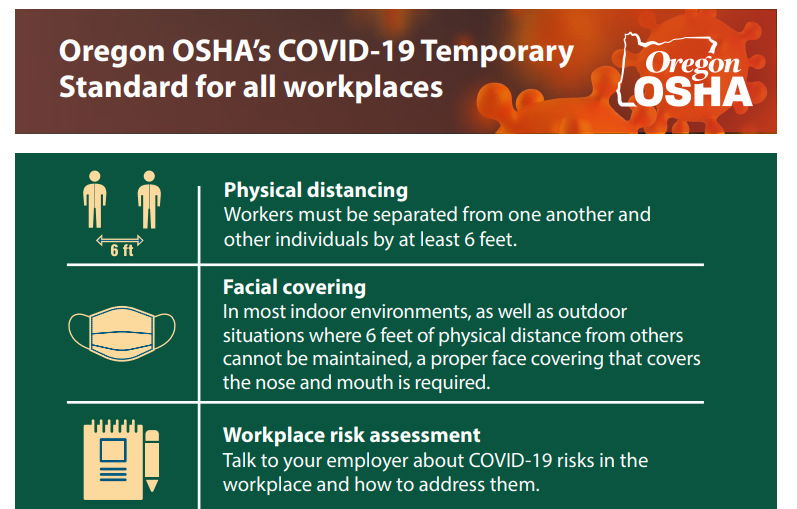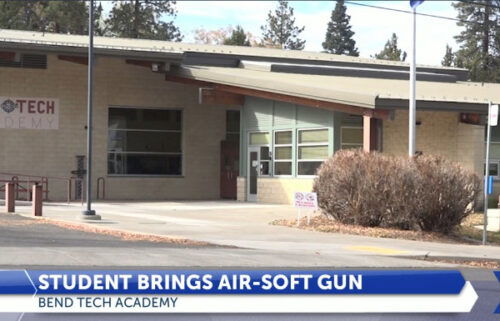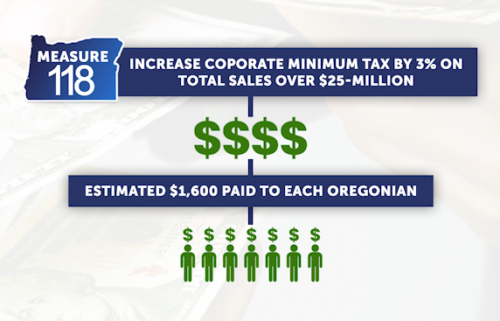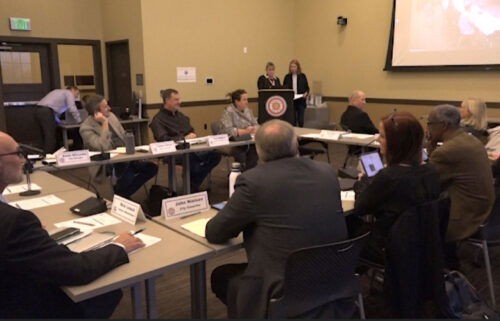Oregon OSHA adopts new COVID-19 temporary rule for all workplaces

SALEM, Ore. (KTVZ) -- Oregon OSHA said Friday it has adopted a temporary rule that combats the spread of coronavirus in all workplaces by requiring employers to carry out a comprehensive set of risk-reducing measures.
The rule will take effect Nov. 16, with certain parts phased in, and is expected to remain in effect until May 4, 2021. It is a continuation of the guidance produced by the Oregon Health Authority and enforced in the workplace by Oregon OSHA, including physical distancing, use of face coverings, and sanitation.
The agency said the rule is intended to further improve the current structure for reducing risks in the workplace by requiring several measures many employers have voluntarily implemented.
For example, it requires employers to notify employees of a workplace infection and provide training to workers on how to reduce risks. Likewise, employers must formally assess the risk of exposure, develop infection control plans, and address indoor air quality within their current capability.
“We believe compliance with this rule will help reduce the serious threat to workers posed by the COVID-19 pandemic,” said Michael Wood, administrator for Oregon OSHA. “It does so by establishing a clear, practical and consistent set of measures for employers.”
Those measures – along with more requirements for exceptionally high-risk jobs, such as direct patient care – are part of Oregon OSHA’s ongoing enforcement and educational efforts to help protect workers from the coronavirus disease.
Beginning in late June, the process to develop the temporary rule included more than a dozen virtual forums dealing with specific issues and industries before the first of four stakeholder review drafts was even developed. And each subsequent draft incorporated changes resulting from Oregon OSHA’s discussion with a large number of employer and worker representatives, as well as feedback from the public at large.
Adoption of the temporary rule brings the requirements within the existing rulemaking authority of the Oregon Safe Employment Act. The law governs workplace safety and health in Oregon, including protections for a worker’s right to raise on-the-job health and safety concerns free from retaliation.
In the weeks ahead, Oregon OSHA will provide educational resources to help employers and workers understand and apply the requirements. Already, the division offers consultation services that provide no-cost assistance with safety and health programs and technical staff, who help employers understand requirements.
The COVID-19 Hazards Poster – provided by the division and required by the temporary rule to be posted – is now available in both English and Spanish. And the division is providing a user-friendly overview table of the temporary rule, summarizing the requirements and how they apply, and showing the effective dates of the phased-in provisions.
Oregon OSHA encourages a careful reading of the temporary rule, which includes an appendix that contains provisions for specific industries and workplace activities. The temporary rule’s requirements include:
Physical distancing
- Employers must ensure six-foot distancing between all people in the workplace through design of work activities and workflow, unless it can be shown it is not feasible for some activities.
Masks, face covering, or face shields
- Employers must ensure that all individuals – including employees, part-time workers and customers – at the workplace, or other establishment under the employer’s control, wear a mask, face covering, or face shield in line with the Oregon Health Authority’s statewide guidance.
- Employers must provide masks, face coverings, or face shields for employees free of cost.
- If an employee chooses to wear a mask, face shield, or face covering – even when it is not required – the employer must allow them to do so.
- When employees are transported in a vehicle for work-related purposes, regardless of the travel distance or duration, all people inside the vehicle must wear a mask, face covering, or face shield. This requirement does not apply when all people in the vehicle are members of the same household.
Ventilation
- Employers must maximize the effectiveness of existing ventilation systems, maintain and replace air filters, and clean intake ports providing fresh or outdoor air. The temporary rule does not require employers to purchase or install new ventilation systems.
Exposure risk assessment
- Employers must conduct a risk assessment – a process that must involve participation and feedback from employees – to gauge potential employee exposure to COVID-19, including addressing specific questions about how to minimize such exposure.
Infection control plan
- Employers must develop an infection control plan addressing several elements, including when workers must use personal protective equipment and a description of specific hazard controls.
Information and training
- Employers must provide information and training to workers about the relevant topics related to COVID-19. They must do so in a manner and language understood by workers.
Notification, testing, medical removal
- Employers must notify affected workers within 24 hours of a work-related COVID-19 infection.
- Employers must cooperate with public health officials if testing within the workplace is necessary.
- If an employee must quarantine or isolate, the employer must follow proper work reassignment and return-to-work steps.
The rule requires more measures for exceptionally high-risk jobs. Such jobs include direct patient care or decontamination work; aerosol-generating or postmortem procedures; and first-responder activities. The additional measures include:
- Detailed infection control training and planning
- Sanitation procedures for routine cleaning and disinfection
- Robust use of personal protective equipment
- Operation of existing ventilation systems according to national standards
- Use of barriers, partitions, and airborne infection isolation rooms
- Screening and triaging for symptoms of COVID-19
Meanwhile, an executive order issued Oct. 23 by Gov. Kate Brown extended COVID-19 protections for agricultural workers in employer-provided housing through the off season.
Following adoption of its temporary COVID-19 rule for all workplaces, Oregon OSHA continues to pursue permanent rulemaking that would provide a structure for responding to potential future disease outbreaks. More information is available on the division’s infectious disease rulemaking page and on its COVID-19 resources page.
###
Oregon OSHA, a division of the Department of Consumer and Business Services, enforces the state's workplace safety and health rules and works to improve workplace safety and health for all Oregon workers. For more information, go to osha.oregon.gov.
The Department of Consumer and Business Services is Oregon's largest business regulatory and consumer protection agency. For more information, go to www.oregon.gov/dcbs/.



